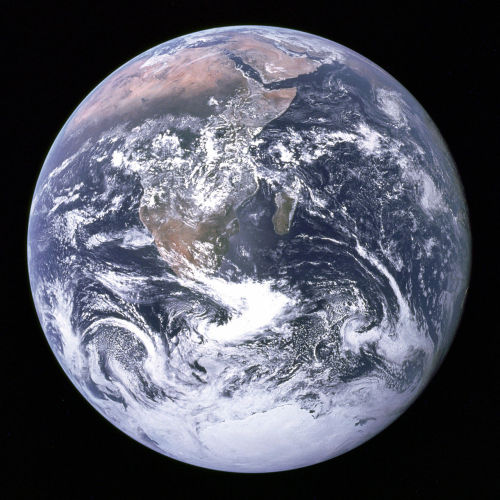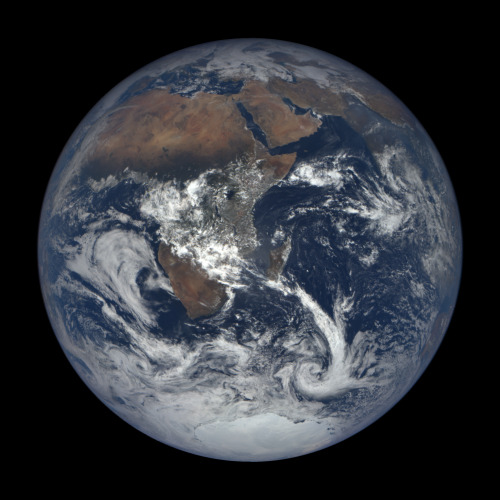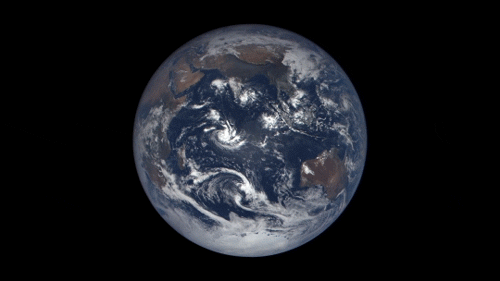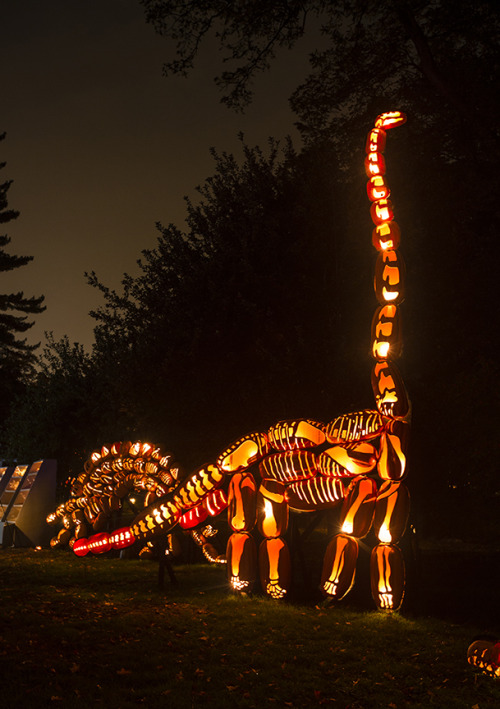Tonight: A Supermoon Lunar Eclipse
Tonight: A Supermoon Lunar Eclipse
(via APOD; Video Credit: NASA’s GSFC, David Ladd (USRA) & Krystofer Kim (USRA) )
Tonight a bright full Moon will fade to red. Tonight’s moon will be particularly bright because it is reaching its fully lit phase when it is relatively close to the Earth in its elliptical orbit. In fact, by some measures of size and brightness, tonight’s full Moon is designated a supermoon, although perhaps the “super” is overstated because it will be only a few percent larger and brighter than the average full Moon. However, our Moon will fade to a dim red because it will also undergo a total lunar eclipse – an episode when the Moon becomes completely engulfed in Earth’s shadow. The faint red color results from blue sunlight being more strongly scattered away by the Earth’s atmosphere. Tonight’s moon can also be called a Harvest Moon as it is the full Moon that occurs closest to the September equinox, a time signaling crop harvest in Earth’s northern hemisphere. Total eclipses of supermoons are relatively rare – the last supermoon lunar eclipse was in 1982, and the next will be in 2033. Tonight’s supermoon total eclipse will last over an hour and be best visible from eastern North America after sunset, South America in the middle of the night, and Western Europe before sunrise.
More Posts from Smartler and Others







43 years ago, on December 7, 1972, the crew of Apollo 17 snapped a shot of the nearly fully illuminated Earth on their way to the moon. It became an iconic image representing Earth’s frailty and the global activist movements of the 70s.
Since then, no human has been far enough away from Earth to capture the entire globe. But thanks to a satellite called the Deep Space Climate Observatory (DSCOVR) we can now see up to date new blue marble-esque images almost every day.
The satellite monitors solar wind and solar magnetic storms to help scientists better forecast severe space weather events that can actually knock out power here on earth. It sits some 900,000 miles away from earth at Lagrangian Point 1, a place in space the pull of the earth and the sun balance each other out and a satellite can maintain a stable position.
On board, NASA’s Earth Polychromatic Imaging Camera (EPIC) is perpetually staring back at Earth, capturing images of our planet and beaming them home. You can see them at this website.



Mug-Ception!
What Are the Bright Spots on Ceres?

Dwarf planet Ceres has more than 130 bright areas, and most of them are associated with impact craters. Now, Ceres has revealed some of its well-kept secrets in two new studies in the journal Nature, thanks to data from our Dawn spacecraft.
Two studies have been looking into the mystery behind these bright areas. One study identifies this bright material as a kind of salt, while the other study suggests the detection of ammonia-rich clays.
Study authors write that the bright material is consistent with a type of magnesium sulfate called hexahydrite. A different type of magnesium sulfate is familiar on Earth as Epsom salt.

Researchers, using images from Dawn’s framing camera, suggest that these salt-rich areas were left behind when water-ice sublimated in the past. Impacts from asteroids would have unearthed the mixture of ice and salt.
An image of Occator Crater (below) shows the brightest material on Ceres. Occator itself is 60 miles in diameter, and its central pit, covered by this bright material, measures about 6 miles wide. With its sharp rim and walls, it appears to be among the youngest features on the dwarf planet.

In the second nature study, members of the Dawn science team examined the composition of Ceres and found evidence for ammonia-rich clays. Why is this important?
Well, ammonia ice by itself would evaporate on Ceres today, because it is too warm. However, ammonia molecules could be stable if present in combination with other minerals. This raises the possibility that Ceres did not originate in the main asteroid belt between Mars and Jupiter, where it currently resides. But instead, might have formed in the outer solar system! Another idea is that Ceres formed close to its present position, incorporating materials that drifted in from the outer solar system, near the orbit of Neptune, where nitrogen ices are thermally stable.

As of this week, our Dawn spacecraft has reached its final orbital altitude at Ceres (about 240 miles from the surface). In mid-December, it will begin taking observations from this orbit, so be sure to check back for details!
ake sure to follow us on Tumblr for your regular dose of space: http://nasa.tumblr.com
What is a Supermoon Lunar Eclipse?

We’ve told you that on Sept. 27 a supermoon lunar eclipse will occur in the U.S. And much of the world, but what does that mean?
One important note, is that this event can be referred to in many different ways:
Supermoon Lunar Eclipse
Super Blood Moon
Harvest Moon Eclipse
Supermoon Eclipse
All slightly different names, but apply to the same spectacular event that will occur this weekend.
Since it’s rare that both a supermoon and an lunar eclipse occur at the same time, let’s break it down.
1) Supermoon

A supermoon is a full or new moon that falls closest to the fall equinox, and is at its closest approach to the Earth. This results in the moon appearing up to 14% larger in diameter.
2) Lunar Eclipse

A lunar eclipse occurs when the moon passes directly behind the Earth into its shadow. This can give the moon a red tint.
3) A Supermoon Lunar Eclipse!

The combination of these two events does not happen very often. In fact, since 1900 a supermoon lunar eclipse has only happened 5 times! The last time this occurred was 1982, and if you miss the event this year, your next opportunity won’t come until 2033.
This year, the event will be visible from the Americas, Europe and Africa on the night of Sept. 27. Here’s a full schedule of the supermoon eclipse:

If it’s cloudy in your area on Sept. 27, don’t worry! NASA Television will be providing a live stream of the event, so you can tune in and enjoy the show.
For more information and resources on the supermoon lunar eclipse, visit our page on NASA.gov.
Make sure to follow us on Tumblr for your regular dose of space: http://nasa.tumblr.com
Submitted by @asapscience
Science is so amazing, but it’s being de-funded around the world. We hope to make a difference with this video:
Your sharing is greatly appreciated.
This is wonderful.
via Phil Plait

A brontosaurus was carved out of pumpkins.










Watch: If you miss tonight’s supermoon lunar eclipse you won’t get another glimpse for a long time.
-
 tronmadmax liked this · 9 years ago
tronmadmax liked this · 9 years ago -
 mtnfemme liked this · 9 years ago
mtnfemme liked this · 9 years ago -
 mengmicin liked this · 9 years ago
mengmicin liked this · 9 years ago -
 unbearablenessofbeing liked this · 9 years ago
unbearablenessofbeing liked this · 9 years ago -
 nirvanaparade liked this · 9 years ago
nirvanaparade liked this · 9 years ago -
 gendervenom reblogged this · 9 years ago
gendervenom reblogged this · 9 years ago -
 gendervenom liked this · 9 years ago
gendervenom liked this · 9 years ago -
 sangsaracycling reblogged this · 9 years ago
sangsaracycling reblogged this · 9 years ago -
 fineapple liked this · 9 years ago
fineapple liked this · 9 years ago -
 hello-hayati reblogged this · 9 years ago
hello-hayati reblogged this · 9 years ago -
 galactic-musicbox liked this · 9 years ago
galactic-musicbox liked this · 9 years ago -
 firefaerie81 liked this · 9 years ago
firefaerie81 liked this · 9 years ago -
 jmarsh-32 liked this · 9 years ago
jmarsh-32 liked this · 9 years ago -
 lizabetta reblogged this · 9 years ago
lizabetta reblogged this · 9 years ago -
 ksherwood46 liked this · 9 years ago
ksherwood46 liked this · 9 years ago -
 shacklesburst reblogged this · 9 years ago
shacklesburst reblogged this · 9 years ago -
 shacklesburst liked this · 9 years ago
shacklesburst liked this · 9 years ago -
 haznotheme reblogged this · 9 years ago
haznotheme reblogged this · 9 years ago -
 haznotheme liked this · 9 years ago
haznotheme liked this · 9 years ago -
 jechen reblogged this · 9 years ago
jechen reblogged this · 9 years ago -
 jechen reblogged this · 9 years ago
jechen reblogged this · 9 years ago -
 3dspacejesus liked this · 9 years ago
3dspacejesus liked this · 9 years ago -
 rangi42 liked this · 9 years ago
rangi42 liked this · 9 years ago -
 scarfboi reblogged this · 9 years ago
scarfboi reblogged this · 9 years ago -
 crankstank reblogged this · 9 years ago
crankstank reblogged this · 9 years ago -
 probablyapyromaniac reblogged this · 9 years ago
probablyapyromaniac reblogged this · 9 years ago -
 smartler liked this · 9 years ago
smartler liked this · 9 years ago -
 smartler reblogged this · 9 years ago
smartler reblogged this · 9 years ago -
 firebreathing-bookworm liked this · 9 years ago
firebreathing-bookworm liked this · 9 years ago -
 lacomtessedargent reblogged this · 9 years ago
lacomtessedargent reblogged this · 9 years ago -
 singerofforgottensongs reblogged this · 9 years ago
singerofforgottensongs reblogged this · 9 years ago -
 meredoubt reblogged this · 9 years ago
meredoubt reblogged this · 9 years ago -
 meredoubt liked this · 9 years ago
meredoubt liked this · 9 years ago -
 ladygreytea76 reblogged this · 9 years ago
ladygreytea76 reblogged this · 9 years ago -
 naked-panda liked this · 9 years ago
naked-panda liked this · 9 years ago -
 bugslug liked this · 9 years ago
bugslug liked this · 9 years ago -
 m-ezzz reblogged this · 9 years ago
m-ezzz reblogged this · 9 years ago -
 rodcover liked this · 9 years ago
rodcover liked this · 9 years ago -
 earthinsoul reblogged this · 9 years ago
earthinsoul reblogged this · 9 years ago